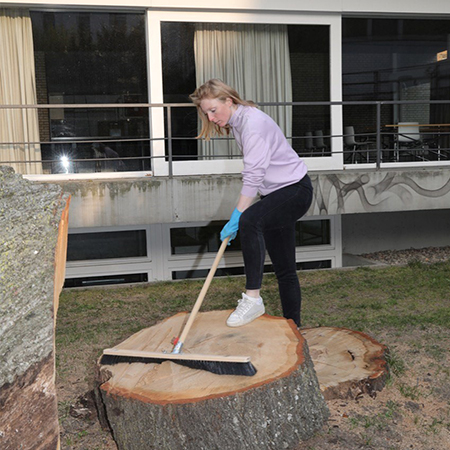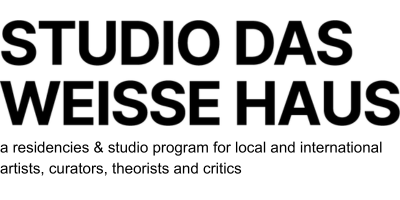Weekly conversations ...with Judith Milz (Artist in Residence)

Judith Milz, born in 1989, has completed her studies at University of Arts and Design Karlsruhe in 2018. From 2014 – 16 she studied at the Academy of Visual Arts Leipzig (HGB Leipzig). Until 2016 she implemented artistic works for the Federal Constitutional Court Germany (awarded with the Guther-Schroff-Scholarship). In 2017/18 she was head of the editorial staff of the magazine Munitionsfabrik. She initiated various exhibitions, such as victory, organized out of the collective feeling a few days after the election of Donald Trump. The group exhibition The Walk– Naples to Pompei (2014), focusing on social, political and territorial questions of the Vesuv was awarded with a scholarship of the ZKM | Centre for Arts and Media.
Judith Milz has a strong interest in the archiving, processing, editing, and visualizing stories and histories dealing with archives and contemporary witnesses in various forms. Simultaneously, the aesthetics of the ordinary are an essential part of her work, the highlighting of seemingly mundane processes, like cleaning or standing on a chair, like minor observations: The decontextualisation of these conventional doings.
As her residency ended on October 30, 2019, she reflects back on her time in Vienna.
Vienna is a place where I still lose my way, while I actually imagine I am finding new shortcuts. On my bike, I had the best times, thinking about ways of how to invent a coherent story for the artistic project I was working on. I was cycling as slowly as I wanted to, no need to rush somewhere, sometimes I just stopped and looked at the facades, the Danube Canal; I would sit on park benches, in the sun, just watching scenes happening around.
I now know the traffic light phases of every crossing on my way from Ybbsstraße, where I lived, to Hegelgasse, where I worked – I guess it’s one step of getting used to a place. I began to secretly follow old white men, suspecting them to be the protagonist I was searching for in my proposed residency project – and I found myself in places I hadn’t known before.
I remember the apartment of das weisse haus, where I lived, in the second district, sunny, with a good view, always warm: It is the nicest area, with broad streets, trees, the Danube nearby and many Gemeindebauten. I got acquainted with the owner of the best vegetable, fruits and juice store, “Vitaminstation 2”, and I ate the best melanzani of my life.
I am very grateful for the people I met in Vienna, the people I shared the studio space with, especially Rafael Lippuner, who tolerated me walking through his studio room (and much more) for two months. I thankfully commemorate Anita Witek, Friederike Steinert and Lena Schwingshandl for corridor conversations, I learned what they do in their studios, how they work, and why – it is people I partly fell in platonic love with, and whom I want to be part of my life for even longer than the two month of my residency.
I recognized there is only 8 Mio. people living in Austria, and 80 off spaces in Vienna, there is at least one venue every night. I remember lining up three times for a sold out Florentina Holzinger dance piece, because I was so intrigued by the posters displayed all over the city, showing her face. It didn’t work out, but I read two books about the Yugoslavian conflict in relation to my project, while doing so.
I remember needing some time to become acclimatized in Vienna, getting to know people while conducting a lot of imbalanced and somewhat akward small talks – it became better after a while. I remember the view through my office window out on Hegelstraße, one of the Viennese facades, it was a canvas with different shades of light each day. It was two month of greatest autumn weather, it only rained single one day, that was it. Once I had accepted, that impoliteness in first contact is part of the local colour and habits in Vienna, I appreciated every bit and piece of nice encounter even more. I have seen many exhibitions and I find it remarkable – and in a positive way unusual – how institutionalized spaces and people intermingle with the artist run spaces and scene – it was good to see that happening.
I am with pleasure thinking back to a studio trip to Steirischer Herbst in Graz: sunniest weather, intrigueing art works, eating Gorgonzola Tortiglioni while having conversation. Thanks to the staff of das weisse haus, Jonas, Katja Stecher, Alexandra Grausam and Synne Genzmer, for this, and for anything else provided during the last two months.
Having been offered a space to work in and to solely concentrate on my artistic project has been an encounter, that has taken me somewhere else on different levels. Being confronted with my own project and having had the need and also the privilege of showing it at the end of the residency, was a structure, that served the ongoing of the research a lot. I could not have done that without the time(!) and space provided by das weisse haus. As result of the residency, we invited for a lecture performance, that I held in the studio corridor on the first floor. It was a place, where I had been sitting regularly the previous two months, reading books, or just looking out of the window into the courtyard or into the sky. The lecture was a moment of trial and error for one narrative, that I had been coming up with for telling the story of my artistic project, it was an opportunity – and I keep it in mind as a success. I’d like to thank Ralo Mayer, who, with his expertise, engaged in an active dialogue about the project, and Nika Kupyrova, who invited me not only into her atelier, but to many other occasions – both of them were part of the jury, that decided about inviting me – thank you above all, for having done so. The residency at das weisse haus, has by all of these means inscripted itself into my body of work and has become part of the film project I have been working on, as well as it has anyway become part of my personal story by now.
